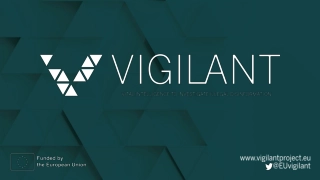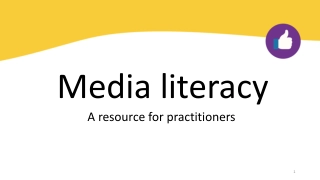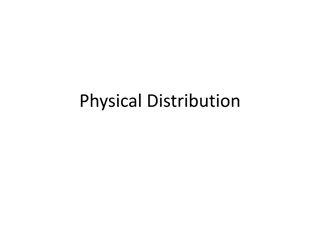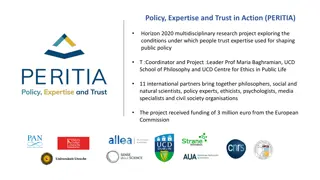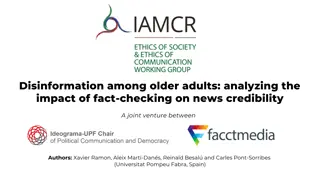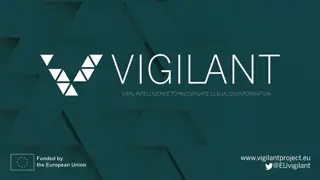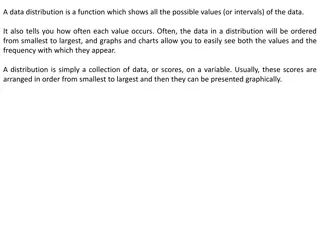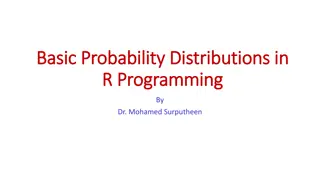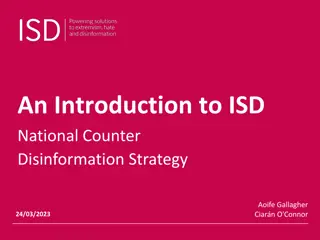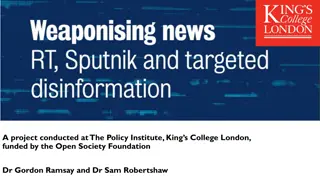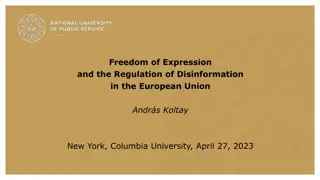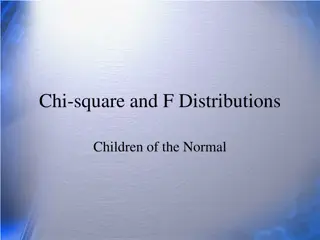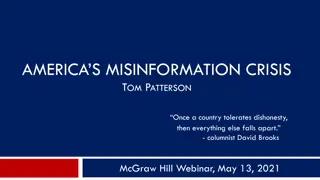Exploring the Impact of UI Design on Disinformation Distribution
This web-based interactive essay and UX project delves into the world of disinformation online through the lens of product design. By analyzing the design elements and features of user interfaces, the project aims to understand how they influence the spread of false information and deception. The exploration spans theories, case studies focusing on platforms like Facebook, and key takeaways like the Complex Influence Effect. Additionally, it references a Stanford Study that compares engagement trends of fake news on Facebook and Twitter from 2016 to 2018.
Uploaded on Sep 21, 2024 | 0 Views
Download Presentation

Please find below an Image/Link to download the presentation.
The content on the website is provided AS IS for your information and personal use only. It may not be sold, licensed, or shared on other websites without obtaining consent from the author. Download presentation by click this link. If you encounter any issues during the download, it is possible that the publisher has removed the file from their server.
E N D
Presentation Transcript
UI Design & Disinformation Miguel Gutierrez, IRI Research Fellow 19 Mentor: Lilian Coral, Knight Foundation
Quad Chart UI Theory Case Study Application Conclusion disinformationdesign.github.io This is a web-based interactive essay and UX project that dissects the phenomenon of disinformation online through the lens of product design. Disinformation Product Design Disinformation is false information intended to mislead. The current literature centralizes on two main camps of inquiry: disinformation as journalistic content or the distribution of disinformation in the context of datafication and algorithms. The critical study of the agendas underpinning the architectural elements of a design artifact. Scrutiny of design processes then reveal the designer s intended affordances to be analyzed in context of user data and/or critical ethnography.
Quad Chart UI Theory Case Study Application Conclusion Research Question How do design elements or features of the user interface affect the distribution of disinformation? UI Theory Here, I trace the theoretical underpinnings of how design operates and why design is a crucial consideration for communication systems and society at large. Case Study Here, I will be looking at Facebook specifically and will be juxtaposing their history with disinformation with their public design agendas.
Quad Chart UI Theory Case Study Application Conclusion Main Takeaways Structural-Behavioral Relationship Affordances are determined by the design object's architectural realization. By this logic, design is not neutral, but instead reflects a carefully calibrated ideology. The Peripheral Paradigm Social media tends to appeal to peripheral information processing. Information is presented in a way that encourages users to pay attention to quick, bite-sized hooks rather than careful, analytical reading. The CIE Complex Continued Influence Effect (CIE) occurs when information that initially is presumed to be correct, but that is later retracted or corrected. The best way to reduce the effect of CIE is through explicit warning.
Quad Chart UI Theory Case Study Application Conclusion Stanford Study, 2018 Compares engagement trends of fake news media between Facebook & Twitter Fake News has declined more than 50 percent between the 2016 election and July 2018, using data tracked by the content marketing firm BuzzSumo. The ratio of Facebook engagements to Twitter retweets on the 570 sites has fallen from about 40-to-1 to about 15-to-1, which implies that Facebook is still by far the larger fake news source. Facing Facts, 2017 Remove Reduce Inform Hate Speech Terrorist Content Fake Accounts Bullying Clickbait False News Sensationalized Headlines Related Articles Background Information
Quad Chart UI Theory Case Study Application Conclusion Methodology I first use the UI Theory and Case Study to form a basis of critical inquiry. Here, I can identify the following: 1. What is the relationship between the design object and audience 2. What is the nature of human psychology amidst digital information spaces 3. How has disinformation on Facebook evolved over time? 4. What design methodologies has Facebook employed? 5. What are the gaps in Facebook s design given what we know about UI theory. From these questions, I conducted ethnographic research on 31 UCLA students. This data then shaped a design proposal to help Facebook resist disinformation.
Quad Chart UI Theory Case Study Application Conclusion Findings Facebook was better equipped at dismantling information after its publishing, but was lacking in means of prevention. From the array of post-publishing measures, most students surveyed (approx 90%) had not known of their existence. Facebook s measures against disinformation were often too dependent on third-party fact checking Design cannot reach its full potential if it is inhibited by speech politics.


